Japan and Religion Part 2
The walk to the next temple took a couple of hours, which gave me a lot of time to think. One of the things I thought about was when I'd taken some friends to Kyoto and visited Kiyomizu Temple. That place is always packed with a hundred tourists, maybe half will be Japanese and half foreigners, and after praying people are taking selfies or eating something, or hanging around chatting while they let their kids run wild. People are trying to take pictures in places that seem the least crowded, and then getting in each others' way. And there are so many ways to spend your money there. It was fun for me because every time I went there, I just blended in to the rest of the tourists. Without that feeling of being singled out, I could relax, take pictures, and participate in some of the activities freely. This was the first temple visit for one of my friends. She was getting anxious because of the crowds. After a while, she veered away from the temple after a while saying she couldn't stand it anymore. And one of her complaints was that no one on the premises was taking any of this seriously.
I'm not sure if she was just overstimulated from the crowded grounds, or she really felt that way, but I understood what she meant and left the temple with her without complaint. My friend had been raised in a Catholic family and the way you approached the sacred was very formalized. It would have been scandalous to be acting in a church the way that everyone was acting at Kiyomizu temple. But that's the thing: This is what Japanese people do at temples. Of course, you have your quiet moment of prayer and give alms to the gods, and maybe light some incense, but you also take selfies, buy snacks for your kids, and treat it as a sightseeing adventure. A pilgrimage isn't a solemn trek to a religious location for deep prayer, it's also a family vacation.
Now, how about in history?
It's easy to see the crowd at Kiyomizu and think that this is just young'uns these days ruining culture. But I found the same impression taken 150 years ago in Lafcadio Hearn's memoires who had the same feelings on his first temple visit. People were sitting on the temple stairs chatting, a small child was trying to climb into the collection box as his mother was chatting with other women obliviously. No one was dressed for the occasion. The whole affair of temple-going seemed so casual to him that at first it threw him off, but then he decided that the Japanese approach to religion was actually superior and that Westerners could learn a lot from it. (He also was invited to drink some tea with a monk, and he thought it was an begging bowl and dropped his money in the tea, to the amusement of all.)
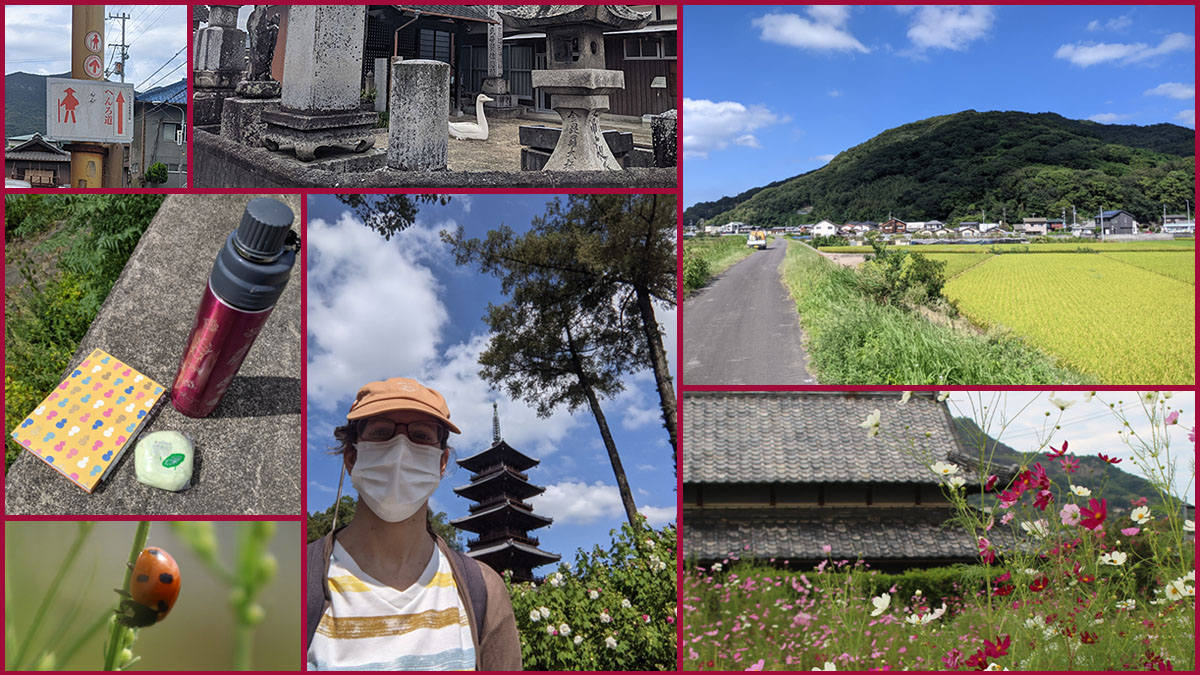
Walking outside under the gorgeous sky, enjoying shapes of mountains new to me in the distance, and watching the rice fields ripple in the wind, I wondered about that moment in Kiyomizu temple. I think that memory sticks with me strongly because I didn't have words to express how I felt. And I still don't. But I realized that I'd almost been in my friend's shoes this morning, giving up an experience because I was taking everything too seriously. Why should religion have to be serious?
Is the fact that it generally isn't taken seriously one of the reasons that people sometimes say Japanese religions aren't real religions?
I arrived at the next temple hot from being under the sun. Here, I found some pilgrims getting out of a van. It seemed to be a group of older people. This temple had a couple small gardens and a pagoda. A man was taking lots of pictures of the pagoda and standing in the middle of the path. A woman was at one of the smaller structures, chanting prayers very loudly and I kept hearing the word "hardship" in her prayers. A cutified picture of a monk on a wooden board informed passerbys that they should recite the Love Sutra and the words were written down. It was completely unintelligible to me. I walked around the whole place twice but I couldn't find the place to get a Goshuin. I almost, almost, thought - Hey I already got one, why do I need more? But I also thought that maybe they would have edible souvenirs, and I was hungry, and I might as well get all the Goshuin I can while I still feel positive about it.
So finally I found it on the other side of a wall, through some rather imposing doors. The area looked private, but there was another wooden board where the cute monk was telling me the bathrooms were through here. On the other side, I found the office where I could ask for a Goshuin, but this time there was no bell to ring, and no one there. I sat down on a bench, drank some water, and rested, until the man with the camera also stepped in, carrying a large book with gaudy gold edges that seemed to be embroidered. He marched up to the window and said, "Excuse me!!" a few times very loudly until a woman came over. He got his Goshuin and afterward the woman said he could have something sweet from a basket. My mouth started watering.
I stood up and went over. Unlike the monk at the previous temple, this woman assumed I knew the drill and didn't even tell me to get out my book or how much to pay. I felt awkward making these decisions by myself. To dispel awkwardness, I decided to ask some questions, and ended up buying a charm that I didn't even want. I guess that since I knew I would be getting a free snack, felt like I had to do something in return. When I had finished paying for everything, she did indeed give me a manju with bean paste inside. I thanked her and left.
My inner thoughts went something like this: I'm getting much better at "doing the right thing" but I am definitely not in the right mentality. I still have so much needless anxiety about going to temples and asking for Goshuin. I'm still too worried about what other people are thinking about me. I'm not acting "myself." I'm not acting like "a pilgrim" either. But neither was that man with the gaudy book. So who am I to judge what it means to "act like a pilgrim"?
The next temple was straight up a long road. I did not calculate how long this road actually was. I zoomed out on my map and took a screen shot of the whole thing, which led me to think that it was actually shorter than in reality. I had such a long time to think. I tried not to think about work. I tried not to wonder how long it would take me. I tried not to think about how tired my legs were getting. To help me with "not thinking about things" I'd brought a ring with the Buddhist Vajra symbol on it. This was given to me by a hiking friend in Kobe, so I wear it for good luck on long hikes. Wearing something on my finger makes me constantly play with it or check if it's there. So I thought every time it bothered me like so, it would remind me to keep my mind present and aware, and not overthink. But that's really hard. There would be long stretches where I'd forget about the ring. Sometimes I was doing well keeping my mind present when I'd have to cross a street, or I greet someone else on the road, and the moment would be lost and I'd be back to wondering how work was getting along, or if my walking pace was too slow, or worrying about the extinction rate of corals. I think this is why people chant. Technically, according to the founder Kukai, you're supposed to chant in meditation the entire time you're walking for a month around Shikoku. (I have never heard of anyone actually doing this, though). I completely see the benefit. It gives you something to focus your mind on, and reminds you to be present. Monks will also count the beads on their rosaries for the same reason. I started trying to sing to myself instead, since I don't know any chants. It didn't really work. The road just felt long. But here's a picture of my best friend on the road: The trail marker!
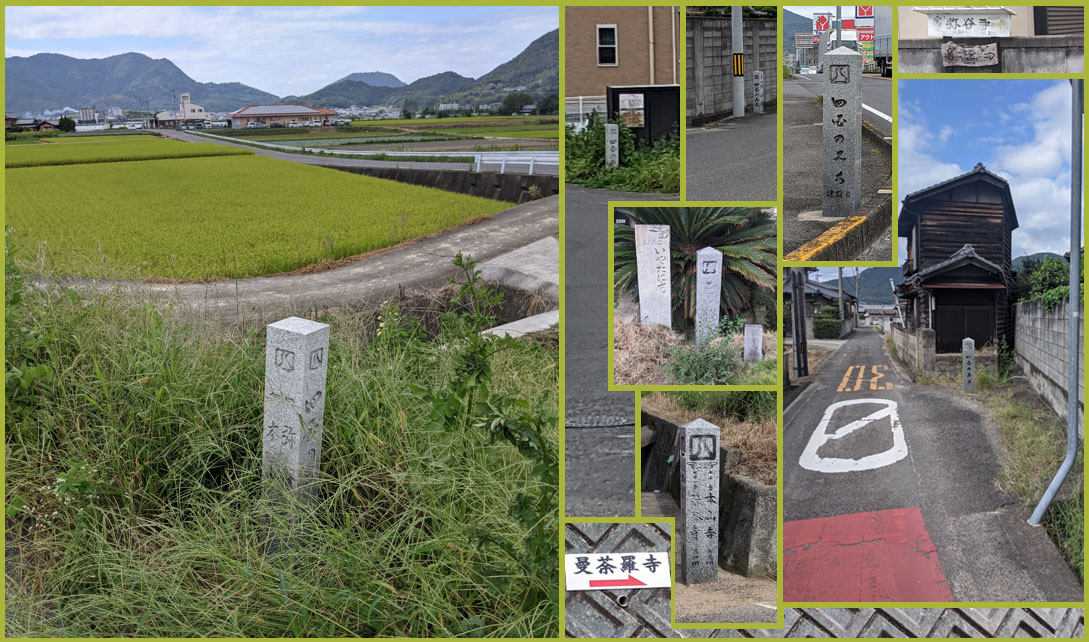
At around 2:30pm, I finally reached the base of a mountain where the next temple would be. Looking at my itinerary, I still had 5 temples to go to. And I'd taken more than half the day. Temples usually close at 4pm. So I didn't have much time to do all of this. My mindset went from enjoying the day to just wanting to get it over with. My legs felt so tired. Was I really going to be able to go to all the temples? What kind of itinerary was this??
On my route map, it looked like I was already at the temple, but because it was uphill and the map didn't show terrain, I realized it was going to still take some time to get there. As I walked up and up the hill, I saw a large building looming ahead of me. Finally the trees parted before me. I was elated to have finally arrived! And I found myself facing. . . An amusement park.
Where was I?? I could not see any signs pointing to Iyadani Temple.
I asked the guy in charge of the roller coaster where the temple was. He pointed out that I'd missed a turn. Walking back, I passed by a little cafe. I wanted so badly to go in, rest my legs, and get a drink, but I was so worried about not making it to the temple by the time their Goshuin window was closed, I hurried further up the hill.
Finally, I arrived at the Iyadani temple gate! My mindset was pretty much, "Let's get this over with and then see if I can find a bus to take me back to the nearest station." I went through the gate and was met with a sign that read, "Path Closed Ahead due to construction. Please go back to the parking lot and walk up through the tollway."
Looking back, there indeed was a closed vehicle road with an empty toll booth to the side. I considered, very briefly, trying to go up the wooded path and see if I couldn't maneuver around whatever construction was going on, but I decided as a foreigner, I should probably show some respect for signs and go the way they told me to. I half ran up the toll road and finally arrived at a statue of Kannon and purification fountain 10 minutes later. My watch said it was just after 3pm.
I took a few steps forward and was met with a map of the area. The temple wasn't just a structure in an enclosure like the last two had been. This had little structures all over a mountainside, complete with a hiking trail if you wanted to visit the castle ruins at the top. My first reaction was, "Well shit." My next reaction was, "Where is the Jennifer that loves this kind of thing?"
I knew I needed to find her. So instead of giving in to my instinct to get my Goshuin and leave for the next temple, I forced myself to sit down on a bench and drink some water for five minutes. Jennifer said to the impulsive side of my brain, "It's only 3pm. There are at least 3 more hours of daylight. Let's enjoy this. We can always go back to the amusement park, pay for a hot bath, and spend the night in a hotel instead of going home. So stop worrying about time." And the impulsive side of my brain settled down a little and started noticing things like carvings in the rock walls and an intricately designed bell. After a few minutes the impulsive side of my brain said to Jennifer, "Hey this place is cool. Let's go climb up the mountain and see the castle ruins."
No.
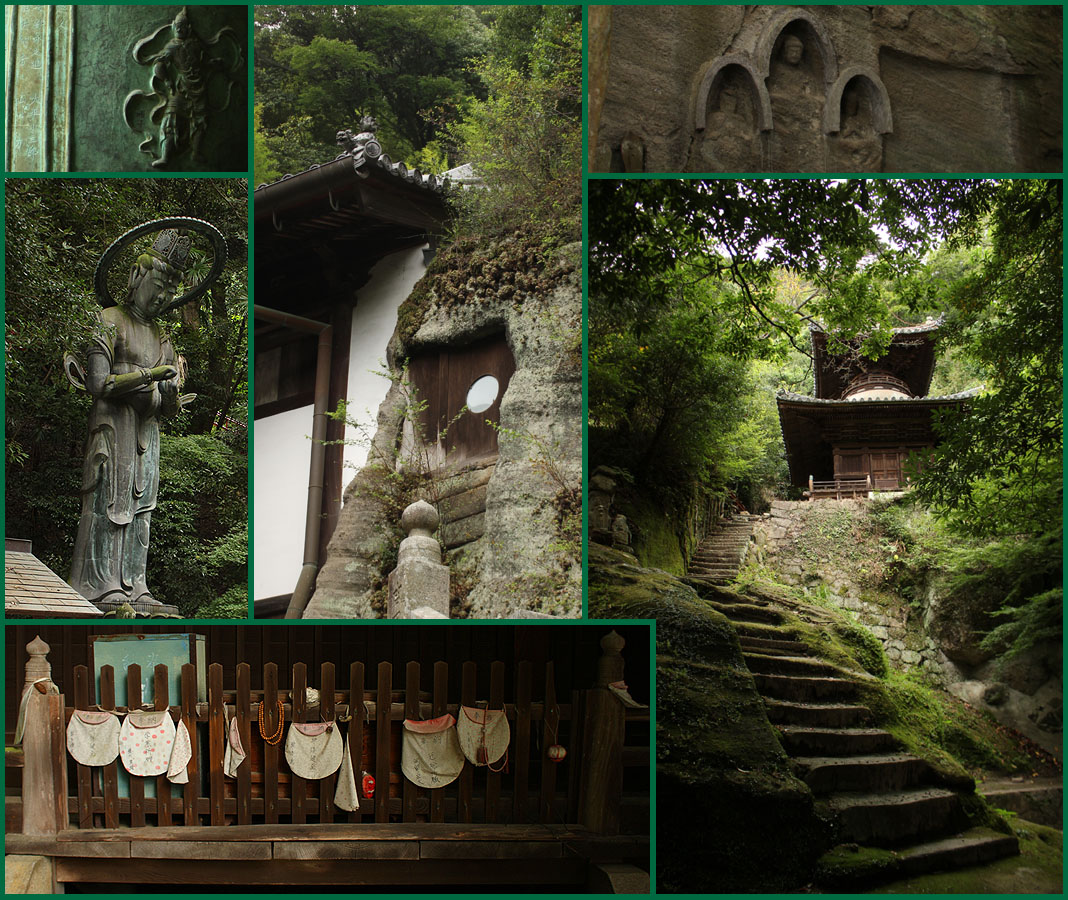
Back to feeling "myself" again, I started exploring the temple grounds. The focal point wasn't an ancient building, but a beautiful rockface where images of Buddha had been carved, then eroded over time, and new ones carved again. A stairway twisted under old trees and up to the top of the rock where you could view the whole valley I'd just walked across until it disappeared into a haze. On my way down I stopped to admire a natural crack in the rock where groundwater splattered out like a fountain, and had eroded away a little alcove that now housed some statues. It seems that in ancient Japan, when people found something naturally beautiful, they assumed the gods were involved, put up a statue, and preserved it as a place to pray. I love that, because no matter how many trees in the forest are cut down, no matter how many islands are razed to make into cement, these places of natural beauty will always, always remain. I wonder if the US would have been like that, if white people hadn't had guns.
I wandered back the way I'd coming when I suddenly remembered my Goshuin. Did temples set into natural stone even have souvenir offices? I found a little gate I'd missed on my way in, which led me to some stairs and a sign telling me to remove my shoes. I didn't know where these stairs were going to go, but if there was a sign, that meant that it wasn't a private area, so I went up the stairs and found an alcove in the natural rock where a statue of the Kobo Daishi sat in permanent meditation. The place was lit with soft lanterns and made the cave glow. I imagined the real Kobo Daishi mediating here, and I realized that this place, Iyatani Temple, was not a mere point on the map for me to pass through, but was rich with meaning and history. I realized I needed to take off my shoes, because the wooden building was a place created for a number of people to actually sit down to meditate peacefully along with this eternal image of Kobo Daishi.
Wow.
And next to this alcove was the office where three monks had nodded off in folding chairs. I didn't feel bad about waking them up, I figured I was giving them something to do with their time. I can't imagine this mountain temple gets a lot of foot traffic and it must be pretty boring for the monks who have to work at the souvenir window. I asked them about the statue and they said that the Kobo Daishi had trained here when he was a young boy. That's right, his birthplace was in the area! After training in China, he came back to this place and found the cave the perfect place to mediate because of the way the light came in. He designated the temple as one of the Shikoku 88, but the temple has actually been around for 1300 years.
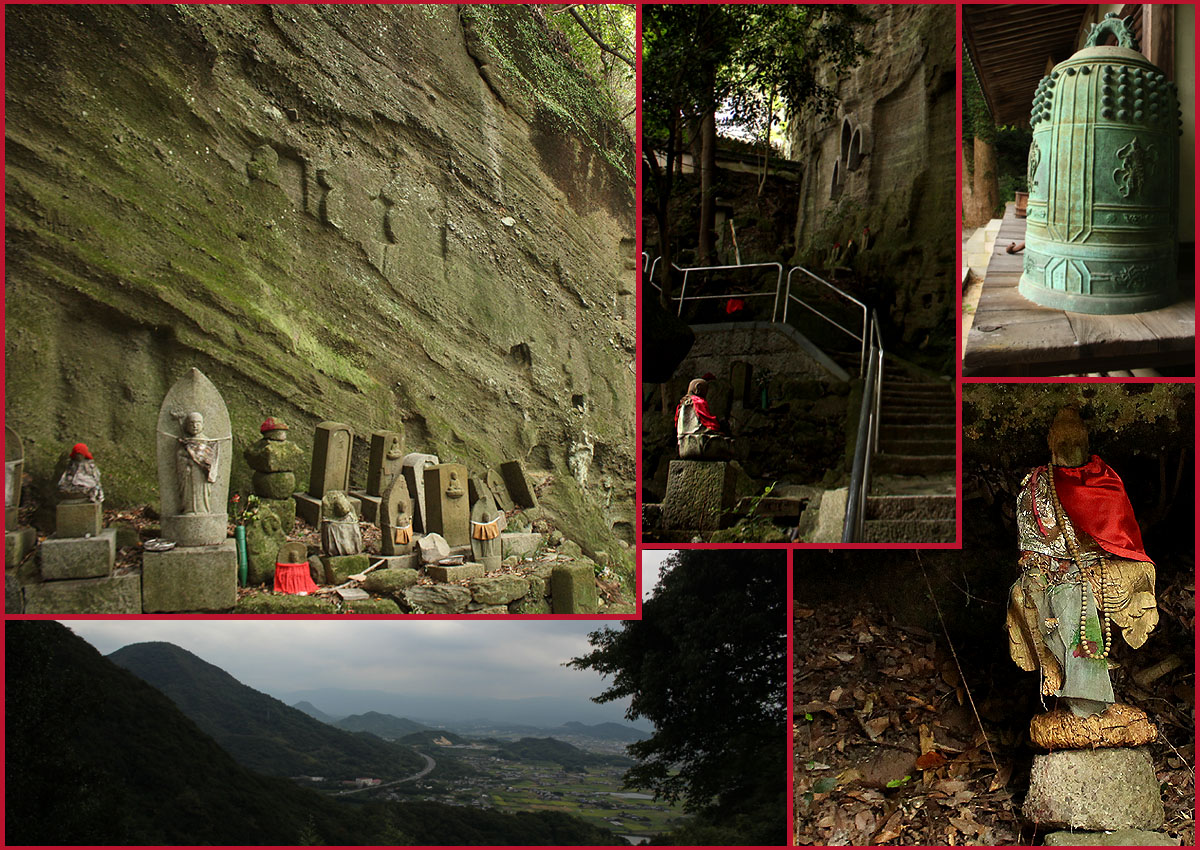
The name of this cave is translated as, "the Lion's Mouth." But as there are no lions in Japan, the word is really referring to a mythical guardian creature. Its open mouth is said to symbolize how it lets in happiness and good fortune. The window of this cave was letting in those things as the young Kukai meditated.
After talking excitedly with the monks and getting my Goshuin, I asked how to get to the next temple. As the main way up and down is blocked off, I was worried I'd have to walk the car street the whole way instead, which would seriously eat into my time. One of the monks who was a woman brought out a map for me. "Here is the shortcut. Go back down to where the way is blocked off. You can slip under the bar and make an immediate right. There's a sign. Follow this trail through the mountain until you get over here." She showed me on the map where to go. "But it takes a little over an hour. You're going to be cutting it really close to closing time."
It was 3:40. That meant that. . . The next temple didn't close until five! What wonderful news! I could at least make one more. And once I was out of the mountains, I wouldn't have to worry about the sun setting or finding my way back to civilization.
I ran along the mountain trail.
I think I owe this to the mountain I currently live near. I've had to deal with so much mountain shit. Giant spiders, pit vipers, wild boars, mud, fallen trees, steep slopes, and pitch darkness. It's just normal to me now. And now running along a thin mountain trail, I found myself at home. Re-energized. I heard some monkeys, had to jump over a few fallen trees, and watch my footing carefully near marshy pond while ducking under a couple spiderwebs, but so many pilgrims had been on this trail before me, it was very easy to follow.
I burst out on the other end to a world of full sunlight. My mind was calm and in the moment. I went back to a walking pace.
It took me 40 minutes to arrive at the next temple. My legs were no longer tired, I just felt good all over. Except I'd almost run out of water. I was hoping the temple would have a vending machine nearby. This was called the Mandala Temple. The concept of a Mandala isn't very common in Japan, but Kukai brought this knowledge back from China and re-named the temple.
At this temple I finally ran into some fellow pilgrims! I asked if they'd seen any vending machines, but they hadn't. Some of them were traveling using local busses, and some of them were part of a tour group and this was the last temple visit on the tour of the day. I was glad I wasn't the only pilgrim visiting temples after 4pm. At the temple gate were two giant shoes made out of rice straw. These symbolize the humble shoes of Buddha and his sacred feet. But as a pilgrim, I realized that these shoes also symbolized my own mad and exhausting journey on foot so far. I'd come such a long way, and there was still more to go.
Wait a minute.
Since when did I start referring to myself as a pilgrim?
Well of course I'm a pilgrim! I'm running around Shikoku visiting temples.
The people on the tour bus are pilgrims, too.
We're all pilgrims, regardless of the level of devoutness, making a journey because a long time ago, a Buddhist named Kukai became the Kobo Daishi and said we all should do this thing. It doesn't matter if WE're Buddhist or not, it matters that HE was Buddhist. Because if we aren't visiting a church, a mosque, or a temple, then it's just plain hiking. And that makes the whole journey so much more mad. We're not mad. We're pilgrims.
I found myself getting closer to the Japanese loose concept of religion, and throwing off my structured, stilted concept of Western religion.
I went in to get my Goshuin and was met with an older monk. He was quiet, not even nodding to my words. That awkward feeling was creeping back. At the other 3 temples, I'd gotten over that feeling by talking and asking questions. But I couldn't think of any questions to ask. It seems the main feature of the temple had been an interestingly shaped tree, but it had died and was gone. There wasn't much to say about the weather. I already knew that the next temple was up the hill and I didn't need a map. What I really wanted to ask was if I could re-fill my water bottle somewhere, but I held that one back. I received my seal in silence, thanked him quietly, and left.
As I exited the temple gates, the word "Mandala" reminded me of the word "Mantra."
Recently I'd watched a Ted talk by JayaShri Maathaa. She said there is one magical mantra that will change your life. I rolled my eyes when I heard that, because it sounded like something a cultist would say. This sounded like a speech that wasn't going to interest me at all. But then she said what the mantra is.
"Thank you"
It is impossible to honestly say those words if your heart isn't at rest.
And it's impossible to say it without focusing on an object of thanks and bringing your mind to the present.
I realized that this is what I need instead of a ring, a chant, or a rosary. I need to just keep saying, "Thank you." Instead of waiting awkwardly for a monk to finish my Goshuin, I could have just repeated, "Thank you" over and over in my head and gotten rid of my anxiety that way.
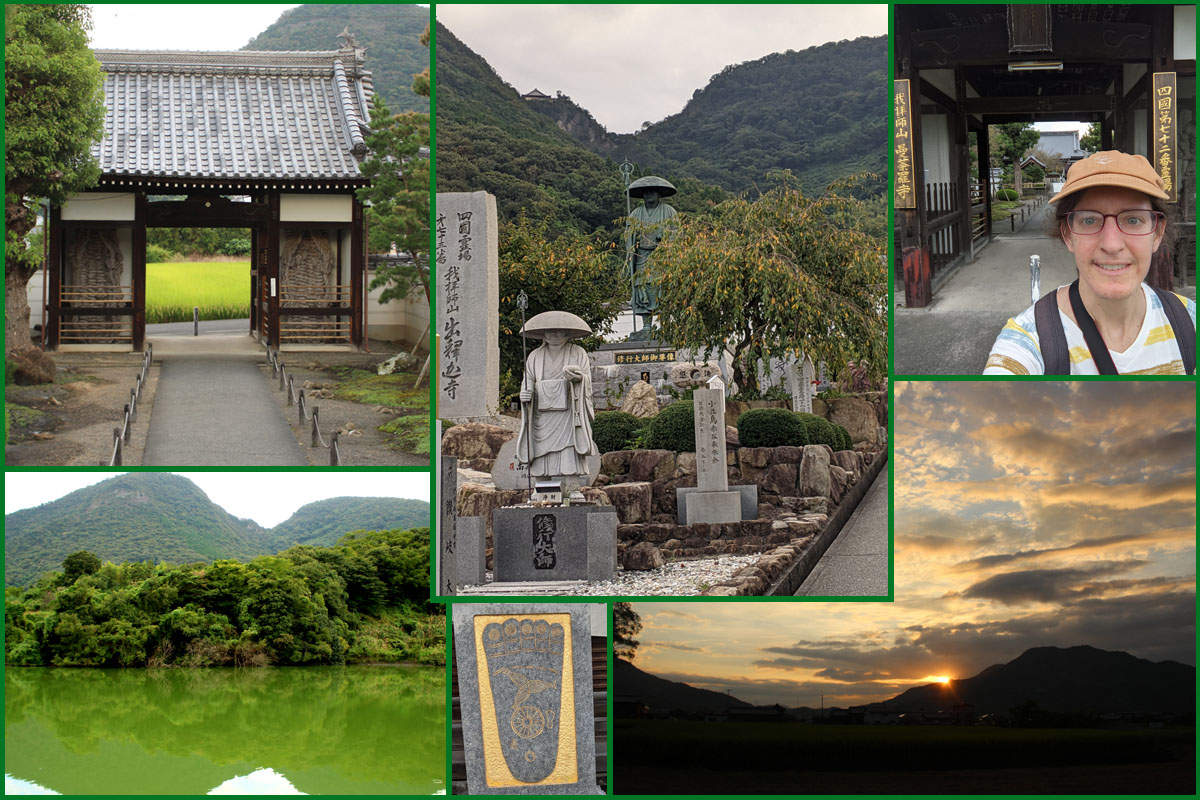
I ran up the hill toward the next temple thinking, "Thank you" at everything I saw. The dark mountain in front of me, the view of the rice fields and distant sea below me, the dragonflies buzzing around me, the sound of a windchime, the other pilgrims, everything got a "thank you" thought at it. And it really worked.
The next temple is at the base of a steep, craggy mountain. It is said that Kobo Daishi jumped off a cliff at the top to test his mental willpower. I don't know about that, wouldn't he have died? It may be a bit exaggerated. But now there is a temple at the steepest part of the mountain in memory of that act. And the temple at the base of the mountain is where you can go instead of having to do any rock climbing, and pray instead of taking a physical leap of faith.
Behind me, suddenly, I found a woman running as fast as she could up the hill. It seems she wasn't just out for a jog. She was panting and dragging her feet in terrible form. There were still 15 minutes until 5, so I wanted to tell her it was all right, but she was completely uninterested in me. She seemed very panicked about time. She went into the grounds and prayed very quickly, then apologizing for being in my way and dove into the souvenir shop. I also wandered in for my Goshuin. I heard her calling out to the people behind the desk breathlessly saying that she 1. Was NOT a pilgrim, so please forgive her for being late. And 2. Needed to buy some object quickly. And 3. Could they please, please do it even though it was so close to closing time because she was NOT a pilgrim and this wasn't just a souvenir.
I think this lady must see us pilgrims as pesky tourists.
But I think she can't say she isn't a pilgrim, as she took the trouble to run up a hill to a religious structure to pray and purchase something.
I wanted to be like the hotel woman. I wanted to put my hand on her shoulder reassuringly and say, "Calm, be calm. What does being a pilgrim or not have anything to do with it?" I wanted to, but I couldn't.
After she left, it was my turn to get my Goshuin. I forgot about my "thank you" mantra and talked about how great the view is. I told the woman I was from Tamano city and I'd been walking since the morning. She seemed impressed. She told me to be careful because the sun was going down, and told me how to get to the nearest station directly, just in case. I thanked her for her kindness and left the temple. The sky was starting to turn some amazing shades of yellow, so I kept stopping to look back over my shoulder as I went on my way. I was impressed by my own stamina. Even thought I'd been walking 8 hours, I didn't feel tired. It's amazing how versatile the human body is! I thanked my legs. I thanked my shoes. I thanked the colors of the sunset. It took an hour to walk to the next temple, and it was closed when I got there. But I didn't mind. I thanked the temple, I thanked the last of the light in the sky. I thanked the music coming over a loudspeaker signifying the end of the working day.
I was back in a city now. At one turn in the road, I found a vending machine encrusted in spiderwebs next to a bench encrusted in advertisements and informational posters. While sitting on the bench, downing my drink, I realized the posters were explanations for kids on what the word "pilgrim" means and why we should be nice to them.
The last temple on my itinerary is in the Kobo Daishi's city of birth. There's a museum and many other attractions in the city, but everything was closed. I could still walk the temple grounds and pray, so I did that and then went straight toward the train station. I arrived there at 7. I'd walked 10 hours. Over 27 kilometers. Received 5 Goshuin. Overcome some mental obstacles.
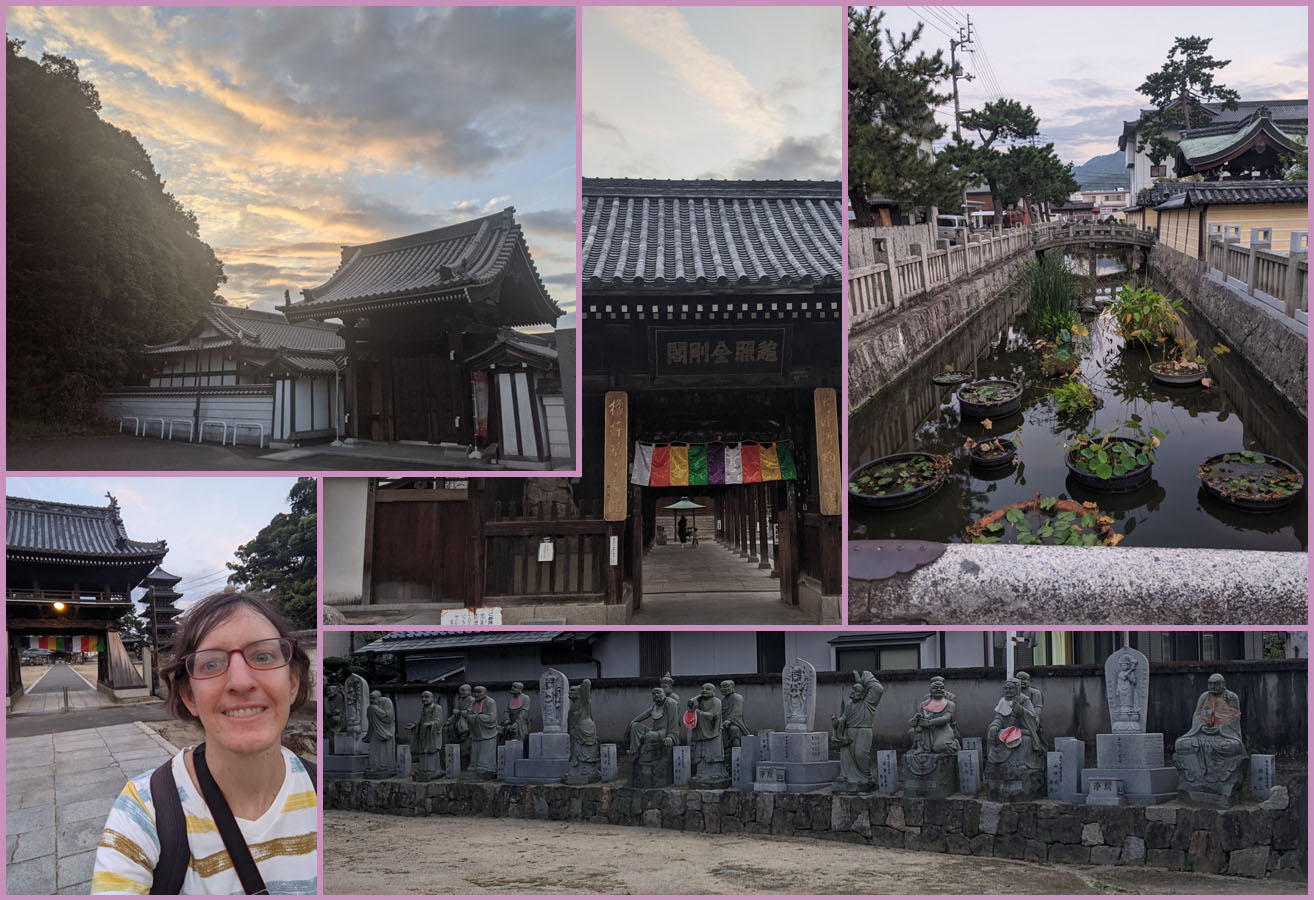
Icing on the cake, the station had pet bell crickets on display.
So what makes a religion a religion?
It can be embarrassing to try a new culture. Even if every single person outside is wearing a feathery hat, sometimes you just can't bring yourself to try one on because you've grown up seeing that as outlandish. But on the other side, if you're the only one not wearing a feathery hat, you stand out. It's just a hat, right? Why wouldn't you?
When I was a kid, some of the boys in my middle school started wearing crosses on necklace chains. I thought that was so brave. It was a statement - I'm manly even with a necklace. I'm manly even if I have a faith. And I had a friend who said grace in public before eating her sack lunch. No one else did that, it was embarrassing.
I guess I was thinking those things because I felt like these boys and my friend were participating in a cultural activity that no one else belonged to. Meaning that "having no culture and only professing your religion while within the walls of a religious building" was normal, and everything outside of that was "brave."
Then these people from my country come to Japan and feel awkward at a temple or a shrine. They don't realize they're the only people not wearing a feathery hat. They don't realize that if you don't wash your hands or put a couple of meager coins in the box, or at least clap if you don't have anything to pray about, that you just look weird. Like walking into a restaurant and taking some pictures instead of eating anything. No one does that.
Of course, feel free to disagree with anything I say or start a discussion about it. I'm not Japanese, so I can't ever hold the last word on any of these things.
But what do you think about religion?
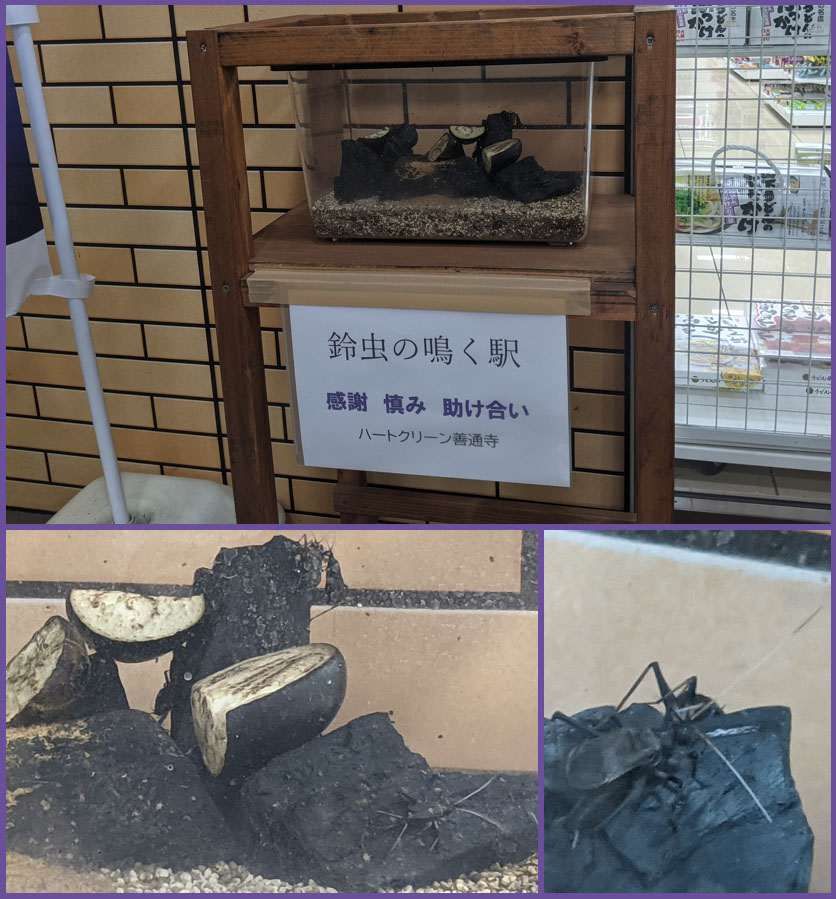
Jennifer